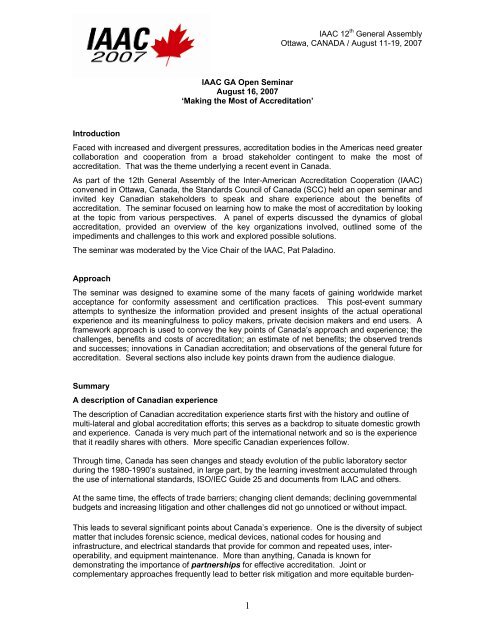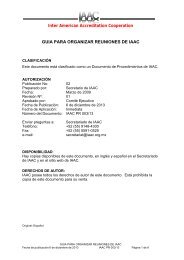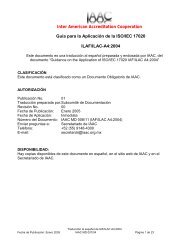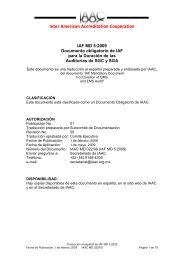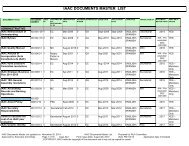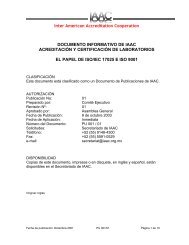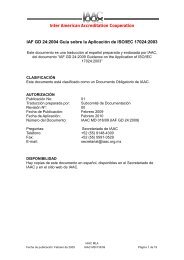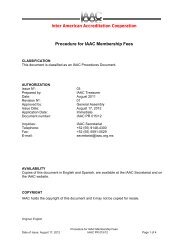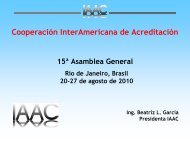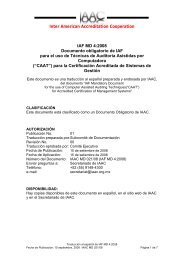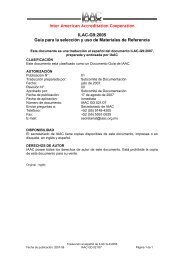IAAC GA Open Seminar
IAAC GA Open Seminar
IAAC GA Open Seminar
Create successful ePaper yourself
Turn your PDF publications into a flip-book with our unique Google optimized e-Paper software.
<strong>IAAC</strong> 12 th General Assembly<br />
Ottawa, CANADA / August 11-19, 2007<br />
<strong>IAAC</strong> <strong>GA</strong> <strong>Open</strong> <strong>Seminar</strong><br />
August 16, 2007<br />
‘Making the Most of Accreditation’<br />
Introduction<br />
Faced with increased and divergent pressures, accreditation bodies in the Americas need greater<br />
collaboration and cooperation from a broad stakeholder contingent to make the most of<br />
accreditation. That was the theme underlying a recent event in Canada.<br />
As part of the 12th General Assembly of the Inter-American Accreditation Cooperation (<strong>IAAC</strong>)<br />
convened in Ottawa, Canada, the Standards Council of Canada (SCC) held an open seminar and<br />
invited key Canadian stakeholders to speak and share experience about the benefits of<br />
accreditation. The seminar focused on learning how to make the most of accreditation by looking<br />
at the topic from various perspectives. A panel of experts discussed the dynamics of global<br />
accreditation, provided an overview of the key organizations involved, outlined some of the<br />
impediments and challenges to this work and explored possible solutions.<br />
The seminar was moderated by the Vice Chair of the <strong>IAAC</strong>, Pat Paladino.<br />
Approach<br />
The seminar was designed to examine some of the many facets of gaining worldwide market<br />
acceptance for conformity assessment and certification practices. This post-event summary<br />
attempts to synthesize the information provided and present insights of the actual operational<br />
experience and its meaningfulness to policy makers, private decision makers and end users. A<br />
framework approach is used to convey the key points of Canada’s approach and experience; the<br />
challenges, benefits and costs of accreditation; an estimate of net benefits; the observed trends<br />
and successes; innovations in Canadian accreditation; and observations of the general future for<br />
accreditation. Several sections also include key points drawn from the audience dialogue.<br />
Summary<br />
A description of Canadian experience<br />
The description of Canadian accreditation experience starts first with the history and outline of<br />
multi-lateral and global accreditation efforts; this serves as a backdrop to situate domestic growth<br />
and experience. Canada is very much part of the international network and so is the experience<br />
that it readily shares with others. More specific Canadian experiences follow.<br />
Through time, Canada has seen changes and steady evolution of the public laboratory sector<br />
during the 1980-1990’s sustained, in large part, by the learning investment accumulated through<br />
the use of international standards, ISO/IEC Guide 25 and documents from ILAC and others.<br />
At the same time, the effects of trade barriers; changing client demands; declining governmental<br />
budgets and increasing litigation and other challenges did not go unnoticed or without impact.<br />
This leads to several significant points about Canada’s experience. One is the diversity of subject<br />
matter that includes forensic science, medical devices, national codes for housing and<br />
infrastructure, and electrical standards that provide for common and repeated uses, interoperability,<br />
and equipment maintenance. More than anything, Canada is known for<br />
demonstrating the importance of partnerships for effective accreditation. Joint or<br />
complementary approaches frequently lead to better risk mitigation and more equitable burden-<br />
1
<strong>IAAC</strong> 12 th General Assembly<br />
Ottawa, CANADA / August 11-19, 2007<br />
sharing among parties relative to the benefits provided as they occur. More will be said about<br />
partnerships later.<br />
The actual definition of accreditation has itself changed with time and experience. No longer<br />
denoted simply as a formal recognition of a body carrying out specific tasks or activities,<br />
accreditation now involves taking account of the overall public interest, and the integrity, quality<br />
system and technical competence of the organizations concerned.<br />
Canada’s collective experience over the past decade or two indicates that its accreditation<br />
system has not only changed but diversified and grown; it is more flexible with less specific, and<br />
more results-based methods and assessments; there is more demonstrable expertise; and it<br />
more actively engages stakeholders including universities and the private sector.<br />
Challenges, benefits and costs of accreditation<br />
Challenges—exist everywhere, system-wide and with public and private sector users as<br />
explained during the seminar. One of these is the lack of direct industry participation in various<br />
bodies; another is some accreditation bodies are not yet signatories to relevant multi-lateral<br />
agreements.<br />
In Canada, various capacity restraints were noted within the economy, government, Parliament<br />
and the fact that the SCC is a statutory corporation restricted by its legal mandate, the policy of<br />
the government of the day and the resources available. In some cases, the very success of<br />
accreditation can result in complacency whereby it is taken for granted by the marketplace and<br />
the broader economy.<br />
This can result in limitations on the availability of voluntary technical specialists and assessors;<br />
assessor training; communications and coordination; and follow-ups regarding non-conformities<br />
and test results when challenged. There is an associated and on-going challenge to ensure<br />
consistency and sound interpretation of assessments as they occur—a system-wide need not<br />
unique to Canada.<br />
A recent and continuing challenge is the pace of change effecting markets and the constant<br />
transitioning from old to new tools and technologies—something shared world-wide. Overall, the<br />
principal accreditation challenge today is to do more, bring better results, faster.<br />
Benefits—Canada’s single-window approach was highlighted. Its use was shown that it can lead<br />
to economic or public sector benefits, from contract simplification to confidence-building.<br />
For the voluntary or private sector, accreditation can provide independent evidence that an<br />
organization conforms to, or uses internationally-recognized best practices; again this puts<br />
confidence into the work performed or the quality of products or services provided; it also serves<br />
as a performance benchmark for the internal management of the accredited body itself. In<br />
particular sectors such as electricity distribution, demonstrated conformity assessment ensures<br />
better integration of standardized requirements, safer distribution of electrical energy and<br />
minimization of product re-testing. Importantly, from a Canadian perspective, it opens up global<br />
markets for electrical manufacturers.<br />
Benefits are also prevalent in public sectors. Noteworthy is the example of the medical devices<br />
program that makes use of the ISO 13485 standard and other features. Through this initiative,<br />
Health Canada is able to achieve its stated mission and regulatory objectives at optimal cost<br />
without diminishing or limiting its policy responsibility for control of safe devices. As well, the<br />
government increases the safety of devices available and improves the quality of life for many<br />
2
<strong>IAAC</strong> 12 th General Assembly<br />
Ottawa, CANADA / August 11-19, 2007<br />
Canadians. Simultaneously, manufacturers of devices are able to demonstrate publicly their<br />
capability as recognized suppliers.<br />
Costs—not much was said about costs of accreditation throughout the seminar although indeed<br />
they exist. In Canada, some costs, e.g., the SCC’s annual Parliamentary appropriation and<br />
revenue stream based primarily on fees are known and publicly available. Some overhead costs,<br />
such as salaries, training, etc. are known or can be traced up and down or across the<br />
accreditation system; so in some respect various, segmented costs can be compiled but, as yet,<br />
the overall aggregative cost of accreditation is unknown for Canada. The same may be said<br />
about other country or regional costs of accreditation.<br />
Net benefits of accreditation<br />
There is anecdotal evidence of net benefits, notwithstanding the challenges and the costs<br />
concerned.<br />
It was revealed, for example, there are some realizations of unpredicted efficiencies as well as<br />
evidence of continual improvement. Both public and private sectors observed instances of more<br />
effectiveness in safety without compromising national requirements as well as better leverage of<br />
management systems certification and use of auditors without building separate systems with<br />
their parallel and attendant costs.<br />
Of particular note was the distinction needing to be made between ISO 9001 certification and<br />
accreditation, i.e., the difference between conformity to quality management (QMS)<br />
specifications, and verification and assurance of competency. It was argued that the real value<br />
equation for accreditation occurs with the delivery of objective and consistent services to the<br />
marketplace, taking into account the commercial dynamics prevailing at any point in time.<br />
Trends and successes<br />
Panelists and others are noting trends in accreditation that include—increasing ISO 9000<br />
alignment across sectors; more and better harmonized documentation, and increasing use and<br />
support provided by information technology.<br />
SCC itself is seeing continued demand for accreditation from existing client sectors and programs<br />
while introducing new programs in response to new or emerging needs, e.g., occupational health<br />
and safety, food safety and others.<br />
Various successes were noted including improved health care and longevity, better electrical<br />
service delivery and safety, higher levels of test result acceptances, better prevention of serious<br />
laboratory error, and overall enhanced supplier-customer confidence—the bottom line of<br />
accreditation.<br />
In Canada, there seems to be more recognition, for example, of third-party evaluations of<br />
laboratory capabilities and competencies within the regulated sectors; also enhanced use and<br />
recognition of accreditation is being made by the courts and the legal system.<br />
Innovation in Canadian accreditation<br />
3
<strong>IAAC</strong> 12 th General Assembly<br />
Ottawa, CANADA / August 11-19, 2007<br />
While not unique, several examples were mentioned of Canada’s efforts to improve its<br />
accreditation programs. These include the importance of reading and understanding the<br />
marketplace, and of accreditation bodies understanding their own strengths and weaknesses.<br />
In Canada, this led the SCC and others to collaborate and design new program structures such<br />
as joint partnerships or multiple-stakeholder efforts in respect to various regulatory needs at the<br />
federal and provincial levels.<br />
Included in the new structures were new features, in some cases custom-designed to enhance<br />
flexibility. Again, the one-window approach to accreditation that involves grouping specialties<br />
under broader scopes for accreditation results in better service to multiple clients, and/or to<br />
multiple programs held within individual client portfolios.<br />
Another example is simply taking the initiative as opportunities arise. This happened in the<br />
case of forensics science and its expansion since 1994 when a WG was first established by the<br />
Canadian Society of Forensic Science; this entailed responding to new Canadian DNA databank<br />
legislation to provide support and assurances of adherence to accepted practices and standards<br />
and provision of proper and credible documentation on test methods, results, reporting and expert<br />
testimony.<br />
Future for accreditation<br />
To be more effective in the future, accreditation bodies need to clearly define and agree on a<br />
definition of purpose and use. One observation is that accreditation bodies need to do much<br />
more to clarify and promote the distinction and value of accreditation, as a tool, over certification.<br />
A suggestion was that this could be supplemented by improving understanding of the varying<br />
value equations for accreditation across sectors, and possibly across economies and regions.<br />
More promotion and continued development of regional and global networks were stressed as<br />
important and beneficial over time at the international level. In addition, involvement of users<br />
from industry; possible reciprocity arrangements among regulatory bodies; more focus on scoping<br />
and other technical issues; plus more support for mutual recognition schemes were felt to be<br />
important. Some countries not yet at the level of recognition are looking for short-term strategies<br />
to improve industry relationships and expressed interest in the Canadian approach of early<br />
inclusiveness, transparency and multi-stakeholder decision-making.<br />
The emergence of supplier declarations was raised as a potential threat to accreditation. Various<br />
discussions, for example, in Europe or at multi-lateral bodies like the Organization for Economic<br />
Cooperation and Development (OECD) and the Technical Barriers to Trade Committee (TBT) of<br />
the World Trade Organization (WTO) were noted by participants. Certain clarifications or updates<br />
on the status of these activities were provided to enhance current understanding and<br />
comprehension of participants. Nonetheless, shared concerns remained, in particular about<br />
product safety issues and the credibility of supplier assertions.<br />
Various stakeholders are now asking accreditation bodies to remain or get involved in these<br />
developments and discussions. There is also a challenge from some parties to encourage<br />
accreditation bodies to consider countering the declaration proponents and actions. At the same<br />
time, there is need for some accreditation bodies to embrace more open competition in markets<br />
and to remove their monopolies in some sectors, or in some regions.<br />
In Canada, it was felt that the future could bring demands in the private sector for more diversity<br />
of action and more service competition. This could result in greater segmentation of accreditation<br />
clients. In certain sectors, there could be more emphasis on supply chain competencies in more<br />
4
<strong>IAAC</strong> 12 th General Assembly<br />
Ottawa, CANADA / August 11-19, 2007<br />
areas of product manufacture and safety, and more emphasis on human resources and<br />
credentialing pushed by concerns about the availability of experienced and competent labour.<br />
These demands are not only national but global and could be triggered, or linked to issues<br />
surrounding corporate governance, management systems, public accountability and ethical<br />
practices.<br />
In the regulated sectors, there could be more demands and partnerships with respect to<br />
infrastructure, product and food safety, carbon management and emission verification. In the<br />
Americas, there is a lot to give and a lot to get from each of these future endeavors; conversely, if<br />
any of these accreditation efforts is not done right, it could result in a lot to lose.<br />
Conclusion<br />
It is clear that all participants are challenging and wanting the accreditation system to improve, to<br />
become better, more viable and more market-relevant while maintaining the backstay of public<br />
interest and safety. Confidence building and maintenance remain paramount.<br />
Arguably, there is need for the accreditation community and its associated economies to make<br />
more extensive use of its design, capacity and any prior investment to bring about more<br />
commercial or public policy outcomes that add to the future of the Americas—more public and<br />
consumer safety, more environmental protection, increased productivity, new products and<br />
technologies, innovations, trade expansion, etc. In Canada, accreditation may still be underutilized<br />
relative to its full potential as a national practice. On balance, it was felt that accreditation<br />
for Canada can result in sound science and overall good management.<br />
On the whole, there is enthusiasm about accreditation. It seems there is merit and hope that in<br />
working together north and south in the Americas, through bodies like the <strong>IAAC</strong>, more can be<br />
done to improve and, in some areas, even lead the rest of the world to better accreditation<br />
outcomes and benefits.<br />
D.A. Durrant, Chairman<br />
SCC/ACCA<br />
23 August, 2007<br />
5


